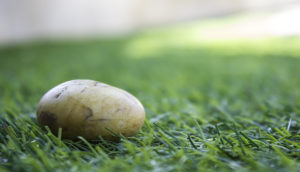 The origins of golf were primitive. Original golf clubs included a long stick with a curved end while the first golf ‘balls’ were nothing more than round stones. The first big improvement came in the 14th century, when golfers started to carve golf balls out of beech wood. The hardwood balls were lighter than stones while still being durable, but the uneven shapes didn’t fly very well.
The origins of golf were primitive. Original golf clubs included a long stick with a curved end while the first golf ‘balls’ were nothing more than round stones. The first big improvement came in the 14th century, when golfers started to carve golf balls out of beech wood. The hardwood balls were lighter than stones while still being durable, but the uneven shapes didn’t fly very well.
In the 17th century, golf balls evolved into a “featherie”, a stitched leather ball stuffed with down feathers. These balls could fly even further than the wooden balls, but they cost a lot more and the leather changed shape when it got wet.
It wasn’t until the 19th century that we would see the next major evolution in golf balls. A Scotsman named Robert Adams Paterson used a type of tree sap to create solid, perfectly round golf balls called gutties. As golfers began to use the new balls they started to notice that older, banged-up gutties were more accurate than new, perfectly round balls. While they couldn’t determine this at the time, the reason they flew straighter is because all the dents and grooves in the old balls caused them to spin. The spinning helped the golf balls follow the trajectory the golfers intended. Once the connection was made between the dents and grooves and straighter drives, manufacturers started cutting grooves into their new golf balls. Now the question was what was the perfect pattern.
The next major golf ball innovation occurred towards the end of the 19th century. Manufacturers switched to rubber balls for added bounce. As the 20th century dawned, they realized that dimples and indentations were more effective than grooves and etchings. As the new balls came to market, experienced golfers realized that if they added enough backspin to their shot they could actually stop the ball from rolling forward.
Today golf balls use advanced materials for both the shell and the filling and you can buy balls with different patterns to provide more control or more distance. We’ll discuss more about golf ball technology in a future Westlake Golf post.
